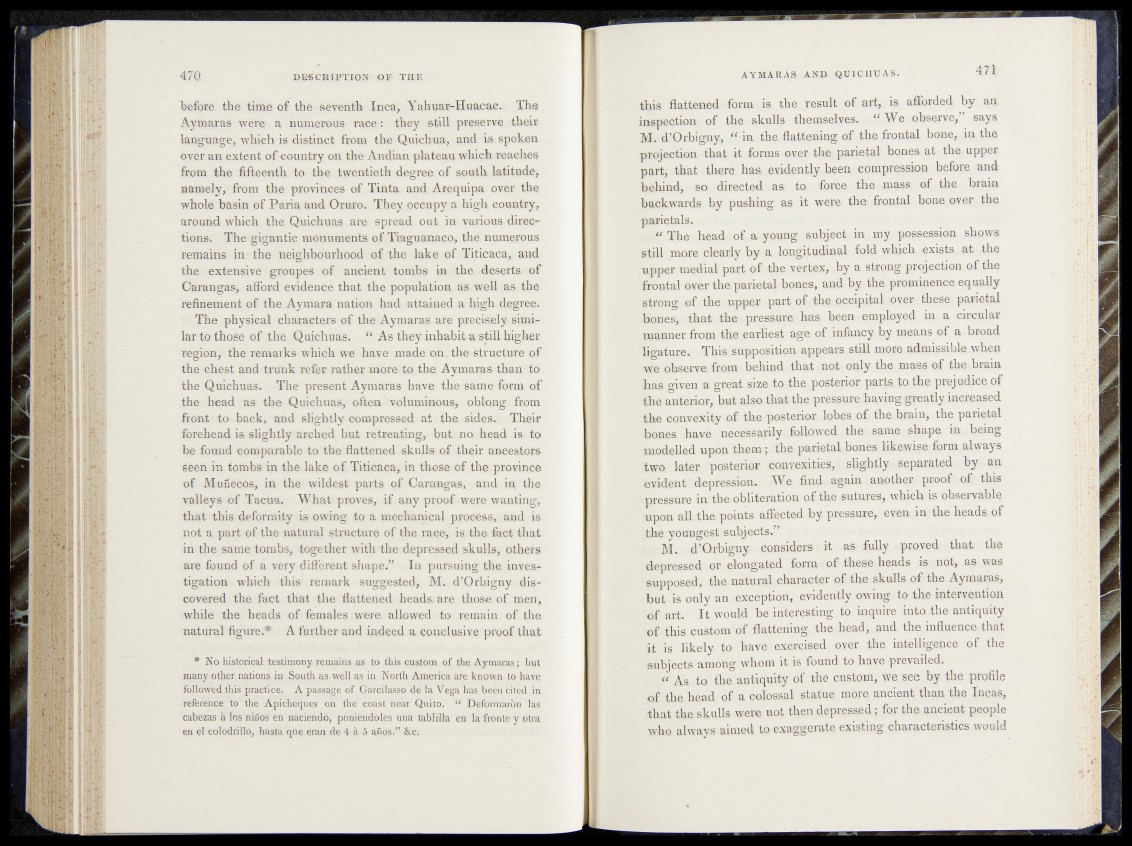
before the time of the seventh Inca, Yahuar-Huacac. The
Aymaras were a numerous race: they still preserve their
language, which is distinct from the Quichua, and is spoken
over an extent of country on the Andian plateau which reaches
from the fifteenth t© the twentieth degree of south latitude,
namely, from the provinces of Tinta and Arequipa over the
whole basin of Paria and Qrnro, They occupy a high country,
around which the Quichuas are spread out in various directions.
The gigantic monuments of Tiaguanaco, the numerous
remains;in■ the neighbourhood of the lake of Titicaca, and
the extensive groupes of ancient tombs in the deserts of
Carangas, afford evidence that the population as well as the
refinement of the Aymaranation had attained a high degree-.
The physical characters of the Aymaras are precisely similar
to those of the Quichuas. “ As they inhabit a still higher
region, the remarks which we have made on, the structure o f
the chest and trunk refer ratbeF more to the Aymaras than to
the Quichuas. The present Aymaras have the same form of
the head as the Quichuas, often voluminous, oblong from
front to hack, and slightly compressed at the sides.. Their
forehead is slightly arched but retreating, but no head is to
be found comparable to the flattened skulls of their ancestors
seen in tombs in the lake of Titicaca, in those of the province
of Munecos, in the wildest parts of Carangas, and in the
valleys of Tacua. What proves, if any proof were wanting,
that this deformity is owing to a mechanical process, and is
not a part of the natural structure of the race,; is the fact that
in the same tombs, together with the depressed skulls, others
are found of a very different shape.” In pursuing the investigation
which this remark suggested, M. d’Orbigny discovered
the fact that the flattened heads, are those of men,
while the heads of females were allowed to remain of the
natural figure.* A further and indeed a conclusive proof that
* No historical testimony remains as to this custom of the Aymaras; but
many:other nations in South as well as in North America are known to have
followed this practice. A passage of Garcilasso de la Vega has been cited in
reference to the -Apicheques on the coast near Quito. “ Deformarbn las
cabezas a los nifios en naciendo, poniendoles una tablilla en la fronte y otra
en el colodrillo, hasta que eran de 4 a 5 an os.” &c.
this. flattened form is the result ©£ art, is afforded by an
inspection of the skulls themselves, “ We ofoperte,” says
M. d’O-rhigny, “ -in the flattening: of the frontal bone, in the
projection that it forms aasser the parietal bones at the upper
part, that there has: esvidently? been compression; before and
behind, so*, directed aft'to- force the, mass of the: brain
backwards, by pushing as it were the frontal bone over the
parietals.
* The head of ayeungHiu^eck in my; possession shows
still more clearly by a. longitudinal- fold which. existft ’Ut the
upper medial part of the, vertex, ,-by a strong, projection, of the
frontal over the parietal bones, and by the prommenoe ecjualiy
strong of? the upper paTbof .tbeidccipital .o'f^: the#© parietal
bones, that the pressure; haft been: employed in a circular
manner from the earliest ageof infancy by §f a broad
ligature.. This supposition: appears still more adtaipp^ble when
we observe from behind that not only the mass of the brain
has given a great, size, to the posterior p^rt&itoth© pmjadico,of
the anterior, hut aJsn that the p e ^ r e havln^reatly i^ e a s e d
the convexity of the posterior lobes of the brain,y the parietal
bones have, necessarily followed tho same shape in being
modelled upon them; the parietaV bones hkewise form always
two later posterior | g
evident~depressien. We find, aguinunother p roofed this
Pressure in thembliteration of the sutures, whfehifi observable
upon all the points aflfeeted by pressure, even,in the heads of
the. y0unges^^Subiectsv, I - ; : ^ « •:
M. d’Qrbigny considers it .aft fully psoyed;: that, the
depressed or elongated form , ofi thesei heads istmat* as. was
supposed, the natural character 0f,the?skulfe of the Aymaras,
but is only an exception, evidently owing to the interventiop.
of art. It would be interesting to inquire ihtodhe antiquity
of this custom of flattening; the infl$3$e§4hat
it is likely to have; exercised over the intelligence v>f .tlfe
sibleets among whom it is found to have-prevailed.1-
“ As to the antiquity of the custom, we see by the profile
of the head of a colossal statue more- ancient than the Incas,
that .the skulls were not then depressed% j p p ^ j p f P ^P 1^
who always aimed to exaggerate existing characteristics would